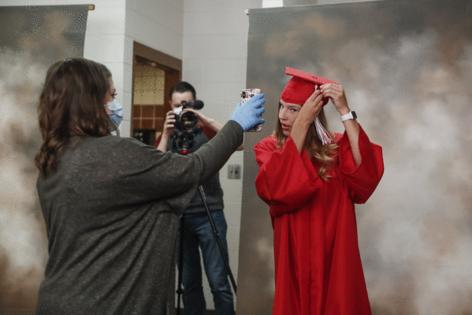Illinois graduation rates hit all time high, but new test score benchmarks make progress unclear
Published in News & Features
CHICAGO — Illinois’ high school graduation rate has hit a 15-year high, as students continue to show academic growth above pre-pandemic levels, state officials announced Thursday with the release of the 2025 Illinois Report Card.
The state’s four-year graduation rate reached 89%, up 6.2% from 2024. Students recorded progress in other key areas, including an increase in the number of ninth graders on track to graduate and a dip in chronic absenteeism.
The annual Illinois State Board of Education report offers a comprehensive analysis of academic, demographic and financial data for every school and district in the state.
“We have a lot to celebrate in this year’s Report Card,” State Superintendent of Education Tony Sanders told reporters at a media briefing last week. “The 2025 Report Card shows clear and encouraging progress across our educational system.”
Based on the new testing benchmarks, 52.4% of students were proficient in English Language Arts, 38.4% in math and 44.6% in science.
This year, ISBE changed how it analyzes students’ standardized test scores, making it difficult to provide a clear picture of year-over-year progress. But student growth — a measure of how much students have improved compared to their peers — continues to show that learning progress in English Language Arts and math exceeds pre-pandemic levels.
“Year after year, more Illinois students are crossing the finish line,” Sanders said.
Chicago Public Schools also saw gains in ELA and math performance, but the district, like the rest of the state, still struggles with chronic absenteeism. Though the rate has declined in recent years, it remains a lingering impact of the pandemic.
•Illinois school report cards 2025: Search results for grades 3-5 in Chicago and the suburbs
•Illinois school report cards 2025: Search results for grades 6-8 in Chicago and the suburbs
•Illinois school report cards 2025: Search high school ACT results for 11th graders in Chicago and the suburbs
Progress in graduation rates, student growth
Illinois’ graduation rate has been steadily rising over the past decade, climbing from 83.8% in 2011 to this year’s record high of 89%. The latest gains were most significant among multi-racial students, Black students and students with Individualized Education Plans.
Sanders called the number “a remarkable milestone,” attributing the success to targeted support for underperforming student groups.
The number of ninth-graders on track to graduate — the best predictor for future graduation rates — is also on the rise. To earn the designation, a student must have five full-year course credits, and no more than one F in a core course. Nearly 90% of ninth-graders were on track in 2025, an 8.6% increase from 2021. The largest year-over-year growth was among English Learners — students whose native language is not English.
Sanders attributed the boost to new investments in schools, including mentoring, recovery courses and broadened access to advanced placement. “These opportunities keep students engaged and on track for success,” he said.
This year, ISBE adopted what they called new, “right-sized” proficiency benchmarks on state tests for “better data on academic achievement and college readiness,” according to Sanders. Illinois previously had the most restrictive benchmarks in the country, which ISBE said risked mislabeling some students as underperforming. For example, an eight-grader previously needed to score a 750 in math on the Illinois Assessment of Readiness to be deemed proficient. Now, they would only need a 745.
That means the state’s 2025 proficiency rates in ELA, math and science can’t be compared to previous years. But students’ growth percentiles — which shows their improvement compared to their peers — remains steady, particularly in ELA.
Some districts are making their own calculations. Staff at Elmhurst Community Unit School District 205, for example, applied the new proficiency benchmarks to past test scores to better gauge improvement. The district still saw proficiency gains across all subjects, according to Superintendent Keisha Campbell.
“We have utilized the current benchmarks, and have done some backwards mapping,” Campbell said. “We’re still seeing that growth.”
Math proficiency lags behind ELA across Illinois, a trend consistent with state history and national data. The Nation’s Report Card, which was released last month, showed high school seniors’ math skills at their lowest in decades. Sanders noted the state is developing a Comprehensive Numeracy Plan to strengthen instruction and bridge the performance gap.
“There is still work for us to do … especially in supporting students who need extra help to reach their full potential in math,” he said.
Overall, about 64% of Illinois schools received a “commendable” rating, based on metrics such as test scores and graduation rates. The tiered designation system determines which schools receive additional funding.
Six schools earned the top rating of “exemplary” in Community Unit School District 200, which serves nearly 11,500 students in Wheaton and Warrenville. The district, which is generally affluent and predominantly white, was above state proficiency averages for both ELA and math.
“Coming out of the pandemic, we knew we wanted to have laser focus on accelerating learning for kids,” Superintendent Jeff Schuler said. “We have certainly seen a significant positive progression of outcomes.”
Chicago Public Schools makes ground
Report Card data on Chicago Public Schools shows significant increases in the district’s reading and math proficiency rates since the pandemic. Since 2022, reading proficiency has increased 11.9%, while math proficiency increased 4.7%. (CPS applied the new proficiency benchmark to historic test scores to compare year-over-year growth.)
CPS also recorded a four-year graduation rate of 84.9%, a slight increase from 84.1% in the previous year. The figure has doubled for the district over the past two decades — in 2000, the graduation rate was just 43.8%.
A majority of CPS students face economic barriers, which makes those gains all the more significant, said CEO Macquline King. Nearly three-quarters of students are low-income, compared to the state average of 49.7%.
“When we say that we’re outpacing the nation on things like math achievement or college enrollment, those achievements are even more incredible, given that more of our students face barriers to success,” she said.
Despite an enrollment decline, the district has added 2,000 teacher positions since 2021. Over the same period, the diversity of teaching staff has steadily grown: Retention of Black and Latino teachers is the highest in a generation, according to Ben Felton, CPS’ chief talent officer.
“We have completely eliminated the gap between white teacher retention and the retention of teachers of color,” Felton said. “We think of that as our Teach Chicago strategy working.”
That trend mirrors patterns statewide. There are more teachers in Illinois than ever before — nearly 137,900, up from 132,355 in 2021. Over the past three years, the state has invested $120 million in teacher vacancy grants to recruit and license new educators.
Illinois Education Association President Karl Goeke told the Tribune in a statement that the data shows progress, but more needs to be done to address the state’s teacher vacancies. The IEA represents 135,000 educators throughout the state.
“The grants are helpful, but are a temporary solution to a larger problem,” Goeke said. “More needs to be done to get talented, high-quality people to join the profession and stay.”
Chronic absenteeism remains persistent
Chronic absenteeism — defined as students who have missed 10% or more of school — dropped slightly this year, but remains stubbornly above pre-pandemic levels. About 25.4% of Illinois students were chronically absent this year, down from 26.3% in 2024. But it’s still far above 17.5% in 2019.
Still, Sanders pointed to this year’s data as “meaningful progress in re-engaging our students.” Nationally, schools have struggled to reduce absentee rates, particularly among low-income students.
Robin Steans, president of education advocacy organization Advance Illinois, called Absenteeism is a “powerhouse predictor,” because it is closely tied to academic performance. Advance Illinois released its own report last month on the state’s education infrastructure, with similar findings to those of the state report card.
“Even as much as missing an incremental day or two really impacts performance,” Steans said.
Last month, Illinois launched a state task force to study chronic absenteeism in K-12 schools. The pandemic, remote learning and schools’ digital presence seemed to have shifted expectations surrounding attendance, according to Elaine Allensworth, executive director and research professor at the University of Chicago Consortium on School Research. Other barriers like transportation and housing instability also play a role.
“It wasn’t just about remote learning, it was about coming back,” Allensworth said. “There are a lot of things that have changed with the COVID-19 pandemic.”
Allensworth added that schools should communicate clearly on the importance of attendance and work to strengthen teacher-student relationships. “There’s just a lot of uncertainty out there right now, and so I think we need to be really clear about how attendance matters in these post-COVID years,” she said.
____
©2025 Chicago Tribune. Visit at chicagotribune.com. Distributed by Tribune Content Agency, LLC.







Comments